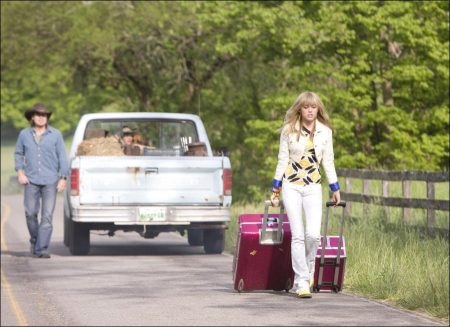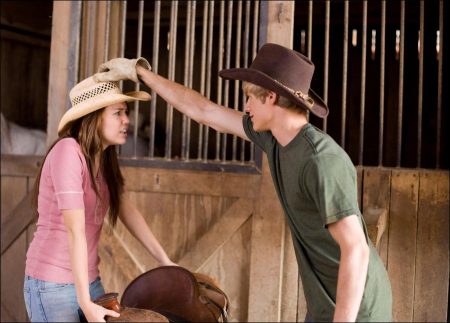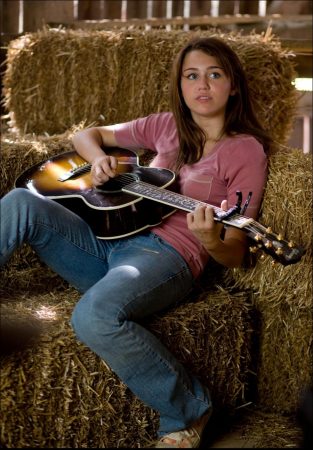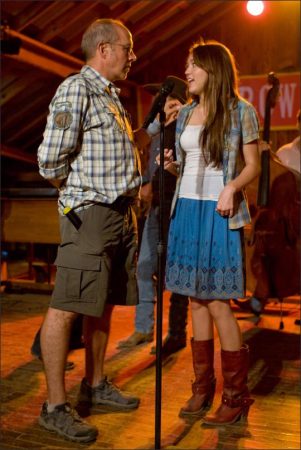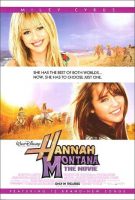Miley and Robby Ray: Back to Tennessee
When the idea for a feature film based on the series was discussed, returning Miley and her father to Tennessee seemed an ideal and natural extension of the characters’ storylines to the big screen. “We wanted to open it up, get it outside and let it breathe,” says Gough about the “Hannah Montana” story. “As we developed the screenplay, we had a couple of rules up front. One was we were not going to use any of the sets on the television show. And secondly, we wanted it to be filmed in real places, actual locations: Nashville, Malibu, the Santa Monica Pier, Beverly Hills.”
Gough’s producing partner Millar adds: “Our goal as the producers was always to make a movie that would surprise people. I think people have an expectation based on the sitcom of a goofy, very broad comedy. But we wanted this movie to have incredible heart, vistas, landscapes, beautiful photography, great dance numbers, phenomenal music and a big scope. And this movie is all of that.”
Another change from the ensemble sitcom format was the film’s focus on Miley rather than on a group adventure or road movie with her series co-stars. Screenwriter Berendsen says: “One of the things that sets this movie apart from the show is that in a good part of the film Miley is on her own. This is about her character, it’s her adventure. It’s something she and her father have to go through together.”
As the film opens, Miley Stewart’s life is out of balance. Taken under the wing of a gung-ho and glamorous publicist, Vita (Vanessa Williams), Miley’s letting Hannah begin to dominate her life. When she keeps choosing Hannah over her commitments to family members-to say goodbye to Jackson as he leaves for college, to attend Lilly’s long-anticipated sweet-16 party or her grandmother’s birthday celebration-it is clear Miley’s beginning to forget why the Hannah Montana secret was created in the first place.
When Hannah Montana ends up in a paparazzi-captured fight with Tyra Banks over a pair of designer shoes, Miley’s father quietly takes control. Having attempted to reason with her to no avail, Robby Ray tricks Miley into thinking she’s going to New York as Hannah to perform when he’s really taking her from Los Angeles back home to Crowley Corners, Tennessee.
Miley’s double life becomes even more complicated when she returns to Crowley Corners. She discovers that a reporter (Peter Gunn) has somehow managed to track Hannah Montana to her hometown and is asking lots of questions of the locals. She also meets up with an old childhood friend, Travis Brody (Lucas Till), and soon finds herself in her first serious romance.
When Miley tries to impress Travis by telling him about her friend Hannah Montana, she suddenly finds her alter ego enlisted in a concert fundraiser to help save her hometown’s pristine Crowley Meadows from developers. Once again, having taken on more than she can handle, Miley has to call on her best friend, Lilly, and ask her for help.
Finding the Right Director
In telling a feature-film-length “Hannah Montana” story, the producers wanted to find a director who would knock down the confines of the sitcom walls and bring Miley/Hannah’s world to a big-screen reality. Producers Millar and Gough needed a performance-oriented director with the breadth of experience to take the film’s wide range of music, comedy and drama and craft a simple, genuine story of a teenage girl searching for her true self.
“If you look at Peter Chelsom’s films, all the ingredients for this movie are in those movies-comedy, family, melody and emotion. Peter covers the gamut in his films,” says Gough. “Peter always gets the performance, it always comes first, and we needed a director to take most of these kids through their first film, especially Miley. Peter was an actor for 10 years working with The Royal Shakespeare Company, The Royal National Theatre and in TV and film, so to have a director who can actually speak to the actors and bring a range of vision and an experienced hand is exactly what we wanted.”
In addition to his strengths as a visualist and performance-oriented director, Chelsom also brought a couple of other highly desirable attributes, including a complete lack of knowledge about the secret pop-star sensation.
“He had never heard of Hannah Montana, which made it even better because we wanted fresh eyes on the material,” says Millar. “We wanted the script to work without knowledge of the show or the characters, and it did. After Peter became involved, of course, he became completely engrossed in watching all the episodes and became a Hannah expert.”
Music As A Second Language
While “Hannah Montana” has always had music, the film takes the music to another level. As the Stewarts travel from Los Angeles to Tennessee, the audience discovers how deeply the family’s lives are rooted in music.
“Peter Chelsom describes the Stewart family as a bilingual family whose second language is music, and that’s very true in this movie,” says Gough.
Chelsom says the film’s numerous songs are tightly woven into the fabric of the story and the characters, which is why he believes the film will feel like a musical without being one. “We continuously dance very close to the convention of a musical but are more integrated. Songs are going to sit within the film, not apart from the film. At times, you won’t notice the music is happening; it’ll just move the story along.”
An example is the song “The Climb.” After troubles with Lilly, her brother, her father, her grandmother and Travis, Miley begins to realize how much her secret impacts the relationships with the people whom she loves. Confused and contrite, she ends up expressing her emotions by writing a song, “The Climb.”
“The song is her journey, the lessons she’s learned in the movie,” says Gough “It’s an epic song, written by a Nashville songwriter named Jesse Alexander with her partner, John Mabe. It’s a power ballad that encapsulates Miley’s journey and the message of the film.”
In total, Miley / Hannah performs 12 new songs in the film, including “Let’s Get Crazy,” “Butterfly Fly Away” and “You’ll Always Find Your Way Back Home.”
The innovative mix of music in the film includes pop, rock, country, hip hop and even a familiar Hawaiian-themed melody. “We realized this was an opportunity to move forward with the music, to update it and make it more sophisticated, to move with Miley’s age,” says Chelsom. “I’ve never had a better musical experience on any film.”
Another musical highpoint comes when Billy Ray Cyrus (as Robby Ray Stewart) performs “Back to Tennessee”-the title song of his latest album-at a fundraiser to save Crowley Meadows from developers. Written by Cyrus, Tamara Dunn and Matthew Wilder, it has as its inspiration Billy Ray’s longing to return to his roots and breathe the sweet southern air of his home state.
Hit singer-songwriter Taylor Swift became involved when the filmmakers approached her about using her music in the film. Swift not only said the filmmakers could use her music, but she’d be happy to perform a song in the movie.
“When I got an email from Disney saying they wanted a song that was perfect to fall in love to and sort of a country waltz, I sent them `Crazier’ and they loved it,” Swift says.
Swift also co-wrote the film’s closing musical number, “You’ll Always Find Your Way Back Home.”
Another song sure to inspire dancing is the “Hoedown Throwdown,” nicknamed “Miley’s Macarena” by the filmmakers, a hip-hop country fusion number in which Miley Stewart gets up on stage and teaches the dance steps to the audience with the song’s lyrics. “We called it `The Project’ for the longest time,” says Chelsom. “I wanted a song that taught a dance in the lyrics of the song like the `Macarena’ or the `Funky Chicken.’ I wanted to maximize Miley’s real silliness physically. She’s physically funny and has great abandon, and I wanted to capture all of that.”
Because the dance steps are the song and the song is the dance steps, creating the musical number became an ongoing collaboration among the songwriters, the choreographer (Jamal Sims), Miley and the filmmakers. Chelsom’s determination to combine Miley Stewart’s L.A. hip-hop / pop style with her country roots in a seemingly improvised dance number eventually produced the show-stopping “Hoedown Throwdown.”
Transcending The Line Between Fiction and Reality
While characters returning home to find themselves again are a staple in classic storytelling, “Hannah Montana The Movie” transcends the line between fiction and reality. In taking Miley Stewart and Hannah Montana back to Crowley Corners, Tennessee, the film transported Miley Cyrus, her father and co-stars back to the Cyruses’ real-life hometown, Nashville, giving the young actress a chance to be home again following her meteoric two-year rise to stardom.
“It’s super important to stay true to yourself and your family and stay in touch with who you are,” says Miley. “When audiences walk away from the movie, I hope they feel like they’ve been to my home. I hope they feel like they understand Nashville because Nashville is my everything. Nashville is who I am.”
With Tennessee being so much a part of the Hannah Montana story-and the Cyrus’ family roots-filming on location there became essential. In fact, Tennessee, like Los Angeles, soon became a character in the film, representing Miley and Hannah’s both real and fictional roots.
For Billy Ray, having the chance to return to Tennessee to shoot the film and be at the family’s farm, where Miley lived until age 13, was truly having the best of both worlds. “In the evenings, after work, she’s out climbing trees, riding horses, she’s that little girl again. She’s Miley,” he says.
Watching and working with his talented daughter is a remarkable experience for Billy Ray. “I’m so proud of her, not only as a daddy in her personal life, but as a musician to see the kinds of songs she writes,” he says. “Then, as an actress to see her evolve from a Lucille Ball-inspired comedienne to a role with some real depth is amazing. I think she brings inspiration to a lot of kids out there to follow your dreams, to pursue what you love and never give up.”
For all the confidence she inspires in others, Miley admits she was nervous about the film role and grateful she’d had the opportunity to develop these characters over time on a series. “What’s been really cool in making the movie is to already understand the characters because of the television show. I was scared out of my mind for half the movie. Making a film is like learning the ropes all over again,” says Miley. “Director Peter Chelsom would say, `OK, I believed that,’ and I thought, `What does that mean?’ Soon, I understood. Our television show can be a little more unrealistic because it’s supposed to be crazy and fun, that’s part of a kid sitcom. But a movie is different. Peter was always saying, `Make it small, very little, you don’t have to do much at all.’”
First Love Interest
In the film, Miley experiences her first serious romance with a former childhood friend, Travis (Lucas Till). Insecure and attracted to the blond-haired, blue-eyed cowboy, Miley drops Hannah Montana’s name thinking Travis will be impressed and possibly be more interested in her. After trying to hide her dual personas from Travis, Miley learns that he actually prefers her-not Hannah-and he feels betrayed when he discovers that she’s been fooling him.
Filmmakers say the role of Travis was the hardest one to cast. Once again, they passed on the idea of stunt or star casting in favor of finding the most real actor for the role of a young southern kid on his way to becoming a man.
“We were basically looking for that young Brad Pitt from `Thelma & Louise,’ and lo and behold, in from CityplaceAtlanta, country-regionGeorgia, on this tape comes Lucas Till. When we brought him in to screen test with Miley, they clicked, and we knew we had our guy,” says Gough.
Till says: “There are a lot of similarities between me and Travis, which really attracted me to this role. Like a lot of southern guys, he’s reserved, and I’m from the South, and I’m a reserved guy. I don’t really like to show my emotions too much, and Travis kind of holds his feelings back. He loves riding horses, and I found out I really love riding horses. So Travis and I, we have a lot in common.”
In creating a romance for Miley/Hannah, the filmmakers wanted to explore the excitement and innocence of a teenage girl’s first serious case of infatuation. “This wasn’t about riding off into the sunset together and everything is happy and done,” says Chelsom. “In this instance, we wanted the two halves of the interest to move in a certain direction and affect each other, particularly Miley. The character of Travis is not just a hunk. It’s about what he represents and how he brings her down to earth.”
For his role as Travis, Till took guitar and piano lessons and began horseback riding a couple of hours a day for a few weeks before shooting began. Till, who had never ridden a horse before beginning rehearsals on the movie, was hooked.
“It felt so good and natural, I should have been on a horse my entire life,” Till says. “I fell in love with riding. It’s an awesome, awesome experience to be able to learn that as part of my job.”
His four-legged co-star, Seabiscuit, was the horse that played the title character in the 2003 film “Seabiscuit,” a true story about a Depression-era race horse that beat the odds.
Filming on Location
The production was divided into shoots in the CityNashville and Los Angeles areas. Near Nashville, they created the fictional Crowley Corners, an idyllic small American town. In Los Angeles, they wanted to show off the California dream-the beaches of Malibu and Santa Monica, the glitz of Beverly Hills, a stadium concert at the Forum.
“We wanted to have some beautiful photography in this movie and really let the locations set the action up,” says Chelsom. “In the first act, it rushes, rushes, rushes, there’s no chance to stop and breathe because that’s the nature of Miley’s life as Hannah and Miley Stewart in L.A. It is frenetic, crazy. Then you get to placeStateTennessee and the pulse completely changes, the style of photography changes and you have this expanse. You can see the horizon, the sky and the landscape. It all opens up.”
For the cast members, taking the characters out of the studio and on to location made all the difference in terms of getting into their roles and understanding the story.
“This movie takes `Hannah Montana’ to another level, a different scale,” says Jason Earles, who co-stars as Miley’s brother in the film and the TV show. Obviously us being out in the real world in beautiful locations with thousands of extras is not something that you can accomplish on a sound stage when you’re shooting a sitcom. The film is grand in scope, but it all comes back to this real place: family and friendships and relationships we’ve created and stayed true to.”
Numerous locations in and around Nashville were used in the film, including the Hermitage Hotel, Maury Airport, Franklin High School, Vanderbilt University, Rutledge Falls, Smiley Hollow, Leiper’s Fork and the Belks Department Store in Cool Springs.
One of the main locations, Grandma Ruby’s farm, was on a 200-acre ranch south of Nashville, just a few miles from the Cyrus family farm. When filmmakers first scouted the location that became Ruby’s farm, the main house was empty and in disrepair, needing both construction and decor. Production designer Caroline Hanania transformed the nearly 100-year-old house into a warm, inviting home in the beautiful Tennessee countryside. Margo Martindale, who plays Ruby, said the details inspired and informed her performance.
“When I first saw this house it was empty and Caroline had just put up some vintage wallpaper,” says Martindale. “When I arrive days later to film, stepping into Ruby’s house was like stepping into my grandmother’s house. Beautifully done, every little detail, even the cabinets the camera never sees. There’s a sewing room all set up, a room where I pot plants. All I had to do was walk around this house and I knew everything about my character.”
Cast and crew also shot in the nearby town of Columbia, Tennessee, where the Stewart’s fictional hometown of Crowley Corners was re-created on the city’s historic town square. With Columbia’s courthouse serving as Crowley Corners’ town hall, one of the film’s most elaborate slapstick sequences takes place as Miley dashes between her dinner with the mayor, dressed as Hannah Montana, and a date she has with Lucas, dressed as Miley, in a romantic Italian restaurant down the street.
Columbia’s town square also serves as a backdrop to the sequence where Miley and her grandmother travel to town to sell Ruby’s watermelons, squashes and jams at the farmer’s market. When Miley spots Oswald, the British reporter she last saw in Los Angeles, and realizes he’s followed her to Crowley Corners, she decides to sabotage him. The extensive stunt-and-effects sequence that follows involves some devilish hot sauce, a 3-D architectural model, 700 pounds of cascading walnuts and an Irish jig.
Another key location in StateTennessee was Smiley Hollow, a rustic corporate retreat and working farm located north of downtown placeCityNashville. Nestled in the rolling hills of Goodlettsville, Smiley Hollow provided the perfect location to create the film’s exterior concert sequences as well as the supper club musical performances and dance numbers. Production designer Hanania and her crew worked for weeks to transform the retreat’s two key locations for the film. This included the retreat’s wooden meeting hall to serve as the Meadows Hall supper club where Robby Ray, Miley and Taylor Swift perform during an open mic fundraiser to save Crowley Meadows from a developer (Barry Bostwick).
Outside the Meadows Hall location was the tree-lined expanse of fields where Hanania and her team created the Crowley Meadows farm and site of the “Save the Meadows” fundraiser. Her team constructed a barn, waterwheel, concert stage, carnival booths and rides. More than 2,000 extras filled the Smiley Hollow location, where both Hannah Montana and Miley Stewart perform several of the film’s musical numbers, including “Rock Star,” “The Climb” and “You’ll Always Find Your Way Back Home.”
The farthest location in Tennessee was Rutledge Falls. After a two-hour drive, cast and crew then hiked to the remote waterfalls where Miley and Travis go for a picnic and swim. “There were a lot of unhappy faces on the crew when they realized how far they had to climb down the rocks with the equipment to get to the bottom where we were filming,” says Chelsom. “But when you look at the scene, I think they’d agree it was so worth it. It’s spectacularly gorgeous.”
Miley’s Los Angeles
After 10 weeks of shooting in Tennessee, cast and crew moved to CityLos Angeles in July 2008 to film exterior scenes in Beverly Hills, Paradise Cove, the Santa Monica Pier and the Forum stadium.
Paradise Cove, a private beach at the northern end of Malibu, served as the backdrop for filming a music video and dream sequence within the film. Hanania and costume designer Christopher Lawrence created a playful retro look in the sequences, filling them with colorful vintage swimsuits and surfboards, a classic woodie surf wagon and a chiseled lifeguard surveying the beach party from his lifeguard perch.
In another example of reality blurring fiction in the film, while Los Angeles-based paparazzi clamored at the perimeter to get shots of Miley, dressed as Hannah Montana, a group of extras, pretending to be paparazzi, chased and shot the pop star for the scene.
In CityBeverly Hills, cast and crew literally stopped traffic when Miley and Vanessa Williams walked down Rodeo Drive to film the exterior location for the film’s shoe-fight sequence with Tyra Banks (the interior of the store, where the fight ensues, was shot previously in a department store in Tennessee). Stopping traffic in Beverly Hills was nothing when compared to the anticipated challenges of filming on the Santa Monica Pier.
Filmmakers admit it was the location they were most concerned about in terms of media and crowds. The pier was also challenging because there was a lot to be filmed in a short period of time, including a skateboard stunt sequence with Lilly, a special effects-rigged exploding birthday cake, Miley’s late entrance dressed as Hannah, several live musical numbers and coverage of all the main cast. However, when the days actually arrived, filming went very well and the crowds of fans and onlookers presented no problems.
Production on the film concluded with several days of shooting at the Forum in Inglewood, California, the former home of the Los Angeles Lakers and L.A. Kings as well as the location of hundreds of concerts. There, the movie’s opening concert sequence was filmed with Hannah Montana performing a couple of her revamped biggest hits for the 1,000 extras on hand. It was also the site for Miley and Lilly’s mad dash on a golf cart, with security guard in pursuit, when Hannah Montana is almost late for her own concert.
In conclusion, Millar says: “Fans who see the movie will know that Hannah is growing up, her music is growing up. This is not the same girl who began on the TV show. Like her character, Miley is a girl from a small town who gets to follow her dream and make it happen. In this film, you’ll see how she’s matured and how she’s growing up, much like her fans.”
Hannah Montana: The Movie (2009)
Directed by: Peter Chelsom
Starring: Miley Cyrus, Emily Osment, Margo Martindale, Jason Earles, Peter Gunn, Melora Hardin, Mitchel Musso, Lucas Till, Vanessa Williams, Margo Martindale, Taylor Swift, Katrina Smith
Screenplay by: Dan Berendsen
Production Design by: Caroline Hanania
Cinematography by: David Hennings
Film Editing by: David Moritz
Costume Design by: Christopher Lawrence
Art Direction by: Elliott Glick
Music by: John Debney
MPAA Rating: G for general audience.
Distributed by: Walt Disney Pictures
Release Date: April 10, 2009
Visits: 142
